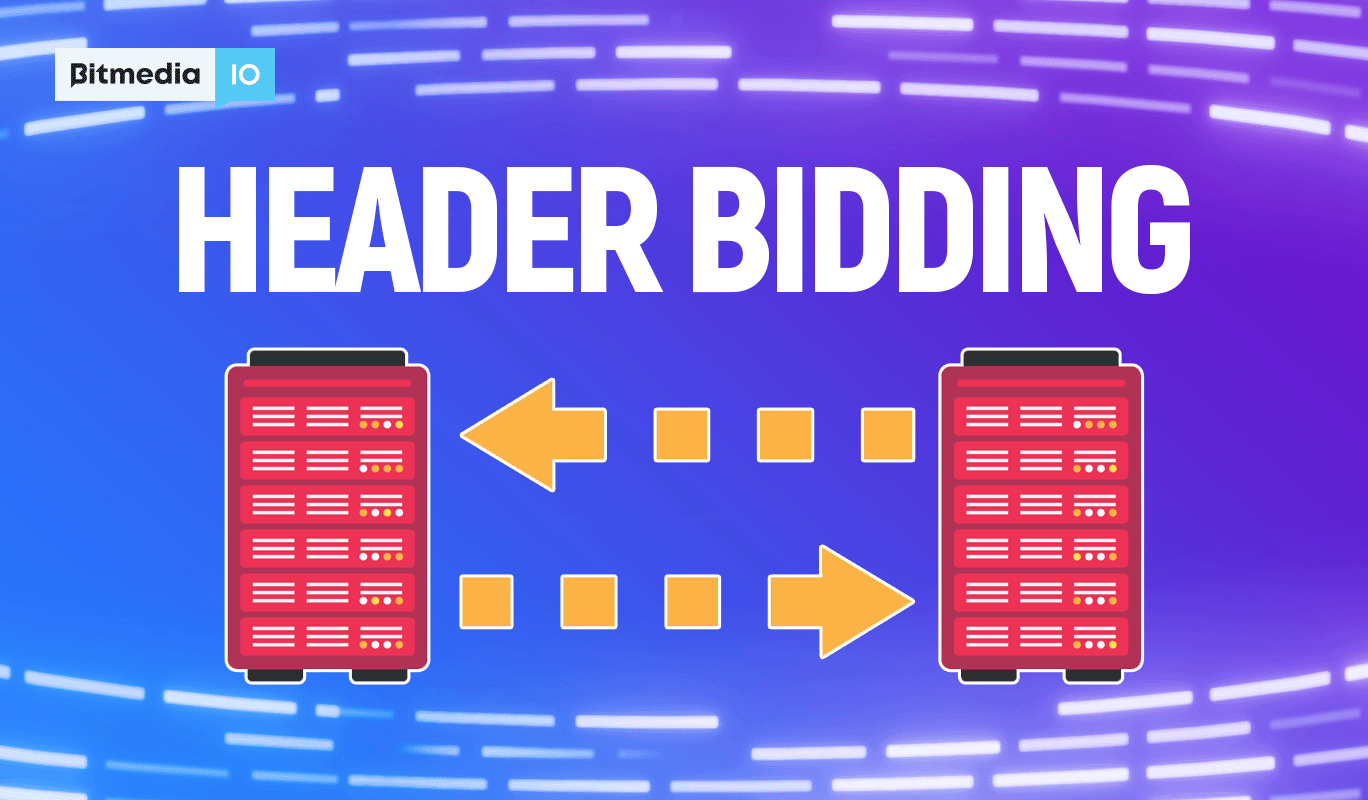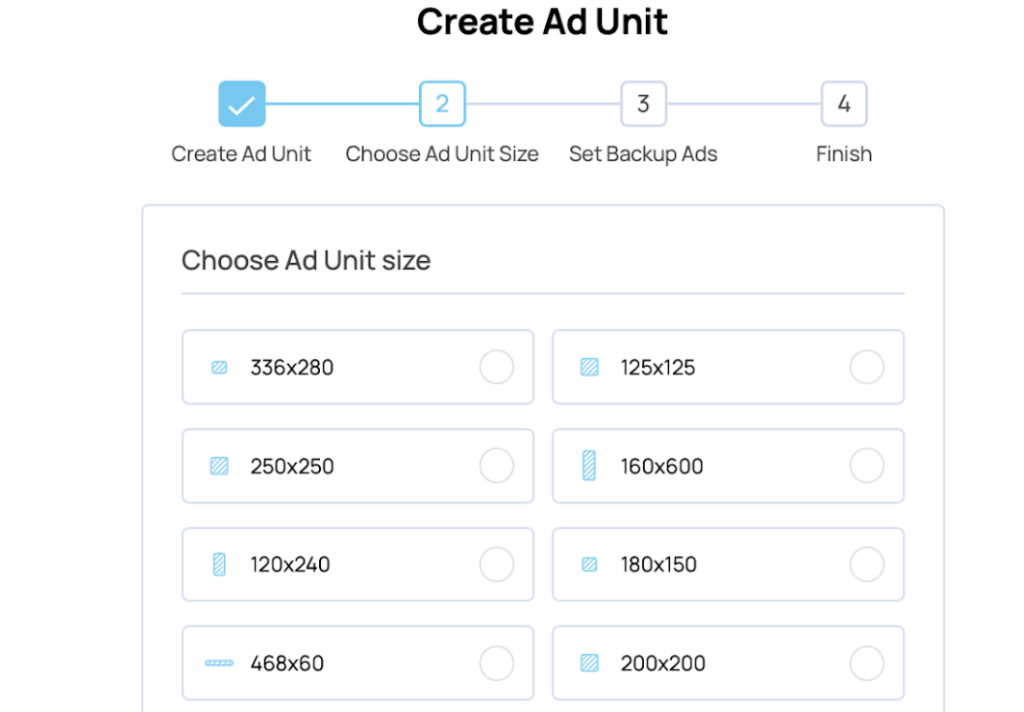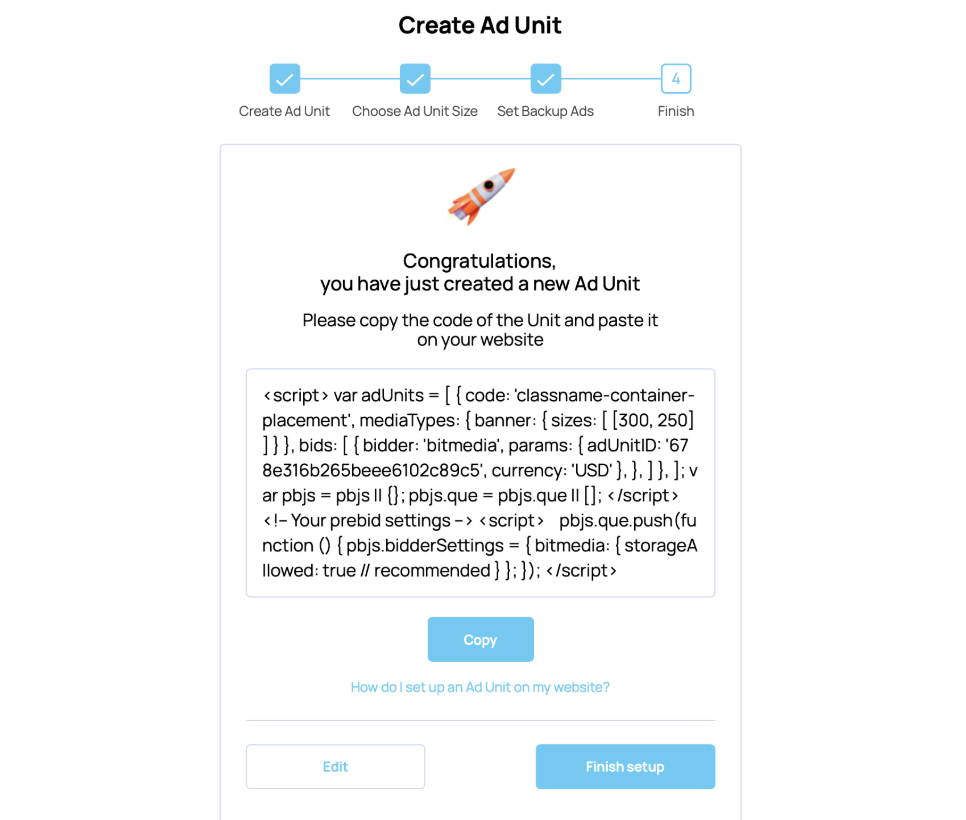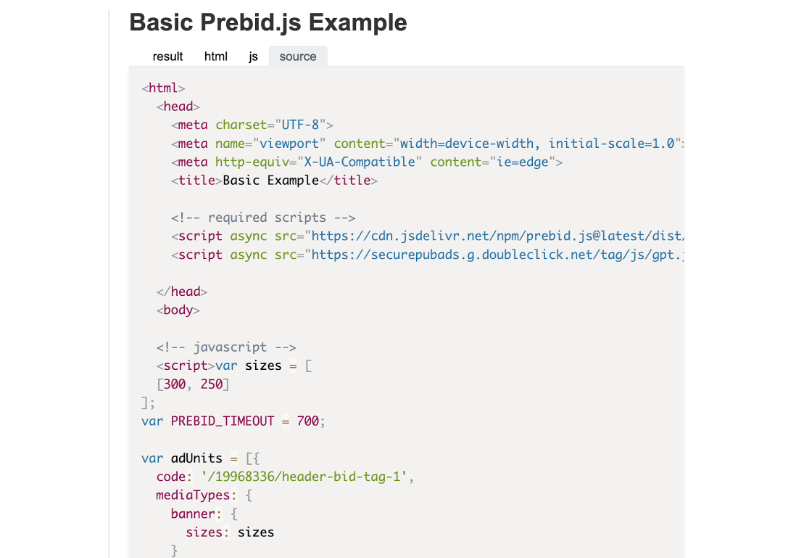What is Header Bidding? A Comprehensive Guide for Crypto Publishers

Header bidding is a transformative technology for publishers, that allows them to offer their ad inventory to multiple demand sources simultaneously. This approach boosts ad revenue through a competitive environment where advertisers bid against each other, leading to increased prices.
Understanding header bidding’s mechanics and its historical context is beneficial, but mastering its implementation can maximize revenue. This guide provides an overview of header bidding, explores setting up options and addresses frequently asked questions to help Bitmedia publishers optimize their ad strategy.
Bitmedia.IO, a leading crypto ad network, is announcing the launch of its innovative Header Bidding technology for publishers. This new feature uses Prebid.js to optimize ad inventory sales in real time, which transforms the way how publishers monetize their platforms.
What is Header Bidding?
Header bidding, also known as advanced bidding or pre-bid, is an alternative to the traditional waterfall method. Historically, publishers used the waterfall process, sending available ad inventory to one demand source at a time. This method has limitations, such as missing out on higher bids from lower-ranked sources, reduced monetization potential, and increased ad load times.
Header bidding addresses these issues by creating an open auction where multiple demand sources can bid simultaneously. This simultaneous bidding increases competition, leading to higher ad revenue for publishers.
How Does Header Bidding Work?
To implement header bidding, publishers must place a JavaScript tag, known as a header bidding wrapper, in their website’s header. This wrapper enables an open auction by inviting multiple demand partners to bid when a user visits the site.
During the auction, ad requests are sent to demand partners with user and webpage details. Advertisers then decide in real-time how much to bid based on this information. The winning bid is processed by the publisher’s and advertiser’s servers to display the ad creative to the user.
Implementing Header Bidding
Getting started with header bidding involves two key considerations:
- Setting Up the Wrapper: This includes adding code to your website, configuring settings like bid time limits, and more.
- Managing Demand Source Accounts: Joining demand sources can be complex, often requiring invitations or meeting specific criteria. Publishers can manage this themselves using open-source platforms or partner with a header bidding expert to handle the process.
Successful header bidding implementation requires addressing several factors:
- Minimizing page latency to maintain a positive user experience.
- Determining optimal ad sizes and placements for maximum revenue.
- Displaying ads to users with ad blockers without penalties.
- Managing user consent laws across different regions.
How to Implement Header Bidding (Predid.js) in Bitmedia Dashboard:
1. Visit the Prebid.js download page and select the Bitmedia adapter and other networks for monetization.
2. Click “Get Prebid.js!” to download the compilation file.
3. Log in to Bitmedia.io’s UI, select your website, and create a new ad block with the Header Bidding format.
4. Choose the ad block size.

5. Receive the Prebid.js configuration code for the Bitmedia adapter.

6. Follow the basic example to configure the Prebid.js adapter on your website.

Partnering with a header bidding expert can significantly enhance ad earnings, potentially increasing revenue by over 50%.
Read the full guide on implementing Header Bidding in Publisher’s Dashboard.
Open-source Header Bidding Platforms vs. Header Bidding Partners
Header bidding can be daunting, especially when deciding between using an open-source platform or partnering with a specialized service. Here’s a breakdown of each option to help you make an informed decision.
Using an Open-source Header Bidding Platform
Opting for an open-source header bidding platform means taking full responsibility for your header bidding technology and strategy. While this approach offers complete control, it also requires significant resources and expertise.
Pros:
- Cost-effective: Open-source platforms, like Prebid.js, are free if you have the necessary development and ad operations skills, allowing you to avoid sharing revenue with third parties.
- Full Control: You have complete autonomy over your ad strategy and can tailor it to your specific needs.
Cons:
- Resource-Intensive: Effective implementation requires a dedicated team of developers and ad ops specialists, which is feasible mainly for large publishers.
- Technical Challenges: Mitigating issues like slow page load times requires developing custom solutions or investing in additional software.
- Payment Delays: Managing multiple invoices and dealing with NET 60 or NET 90 payment terms can delay revenue, unlike partners who offer NET 30 terms.
Large publishers with the resources to hire dedicated teams for header bidding implementation.
Working with a Header Bidding Partner
Header bidding partners offer varying levels of service and ad tech solutions, connecting you to multiple demand partners and assisting with initial setup.
Pros:
- Comprehensive Support: Partners like Bitmedia provide a full-service approach, assigning ad management experts to create and manage customized ad strategies.
- Advanced Technology: Access to AI-powered tools like AI bidder optimization, adaptive ads, and adblock recovery, which can significantly boost revenue.
- Simplified Payments: Partners handle payments from SSPs, typically offering NET 30 terms for faster revenue.
Cons:
- Limited Control: Depending on the partner, you may have less flexibility in adjusting your ad strategy.
- Dependency: Relying on a partner means entrusting them with your ad operations.
Publishers who prefer a hands-off approach and want expert assistance in maximizing ad revenue without managing technical complexities.
Bitmedia’s Header Bidding Stack is A Game-Changer for Publishers
To explore the various types of header bidding partners and determine the best fit for your website, check out our comprehensive guide on header bidding solutions. Contact us today for a personalized assessment of how Bitmedia can boost your ad revenue.
Main advantages of header bidding for publishers:
- Increased Revenue: Header bidding maximizes competition for ad spaces, often resulting in higher bids and increased revenue for publishers.
- Access to More Demand: Publishers can integrate multiple demand sources, increasing the pool of potential advertisers and improving the chances of filling ad inventory at the best possible price.
- Improved Yield Management: Header bidding provides publishers with greater control over their inventory, allowing them to optimize yield by selecting the highest-paying ads from various demand partners.
- Enhanced Transparency: With header bidding, publishers gain insights into the bidding process and advertiser demand, enabling more informed decision-making and better inventory management.
- Reduced Reliance on Waterfall Model: Unlike the traditional waterfall model, header bidding allows all demand sources to compete on equal footing, reducing latency and inefficiencies associated with sequential bidding.
- Better User Experience: Header bidding can improve page load times and overall user experience, leading to higher engagement and retention.
Any publisher lacking the technical expertise or resources to independently manage a complex header bidding stack should consider partnering with a header bidding company.
What to Look for in a Header Bidding Partner:
- Product Offerings: Ensure they provide what you need—some offer just header bidding, while others include consent management, programmatic deals, and video ads.
- Business Model: Decide if you prefer a plug-and-play solution or a full-service consultancy approach.
- Site Priorities: Consider whether the company focuses on revenue, user experience, or site speed, and ensure they can help improve Core Web Vitals like FCP, CLS, and FID.
- Payment Terms: Check their payment terms—some offer net 90 days, while others pay as quickly as net 30 days.
- Service Quality: A good ad ops person can make a significant difference. They should be knowledgeable about ad placements, video vs. interactive units, and continuous testing and improvements.
- Company Values: Ensure their values align with yours, whether they focus on service, performance, or both.
Choosing the right header bidding partner can dramatically enhance your ad revenue and overall site performance. Consider these factors carefully to make the best decision for your business.
Conclusion
Header bidding offers publishers a powerful tool to maximize ad revenue through competitive bidding. Implementation of this technology helps publishers to overcome the limitations of traditional ad sales methods and unlock new revenue opportunities.
Choosing between an open-source platform and a header bidding partner depends on your resources, expertise, and desired level of control. While open-source solutions offer autonomy, they require significant investment in personnel and technology. Conversely, header bidding partners provide expert support and advanced technology, alleviating the burden of managing ad operations in-house. Consider your specific needs and capabilities to determine the best path for optimizing your ad revenue.
FAQs About Header Bidding
What Are the Pros and Cons of Header Bidding for Publishers?
Pros:
- Increased Revenue: Publishers often see a revenue boost between 30% and 70% by using header bidding, as it fosters competition among advertisers, driving up CPMs.
- More Control: Publishers can select which demand partners participate in auctions, ensuring high-quality ads and better monetization.
- More Competition: Multiple advertisers bid simultaneously, increasing competition and revenue from ad inventory.
- Easy Management: With a reliable header bidding partner, managing the technology becomes plug-and-play, reducing administrative burdens.
Cons:
- Complex Implementation: Header bidding technology can be complex, requiring expertise for setup and maintenance.
- Impact on Page Load Times: Depending on the solution, header bidding can affect page speed, though asynchronous loading can mitigate this.
- Initial Revenue Fluctuations: Some publishers may see initial revenue dips, but performance improves with optimization.
When Did Header Bidding Start?
Header bidding emerged in 2014 to address the limitations of the Real-Time Bidding (RTB) waterfall model and counter Google’s market dominance. Initially called tagless or pre-bidding, the term “header bidding” gained popularity in 2015, facilitating widespread adoption.
What is a Header Bidding Wrapper?
A header bidding wrapper is a JavaScript code snippet placed in a website’s header, allowing publishers to access multiple demand partners and conduct profitable RTB auctions. It simplifies adding or removing demand sources, enforcing timeout settings, and managing ad auctions efficiently.
What is the Difference Between Client-Side and Server-Side Header Bidding?
- Client-Side Header Bidding: Conducts auctions within the user’s browser, potentially increasing latency with more SSPs.
- Server-Side Header Bidding (S2S): Conducts auctions externally, reducing ad calls and improving page load times and user experience.
What is Prebid.js?
Prebid.js is a popular open-source header bidding platform developed by Xandr. It allows publishers to manage multiple ad calls, supports currency conversion, GDPR compliance, and provides analytics. While powerful, it requires technical expertise for setup and maintenance.
The Pros of Using Prebid.js:
- Open Source: Free to use with the necessary skills, avoiding third-party revenue sharing.
- Community Support: A resourceful community offers help and insights.
- Analytics Access: Provides data on performance and partner effectiveness.
- Adaptability: Suitable for both mobile and desktop platforms.
- Fast Auctions: Supports over 300 demand partners for quick auctions.
The Cons of Using Prebid.js:
- Complexity: Requires significant technical knowledge for implementation.
- Potential for Slower Page Loads: Client-side auctions can delay page speed.
- Lack of Dedicated Support: Forums offer help, but expert support may be needed.
- No Built-in Demand Sources: Requires setting up accounts with multiple SSPs.
How Does Google Open Bidding Work?
Google Open Bidding allows third-party demand partners to compete in a single auction via server-to-server integration. Ad Manager runs a unified auction, enhancing competition and yield.
Is Header Bidding Good for Advertisers?
Yes, header bidding benefits advertisers by providing access to premium inventory, maximum transparency, and equal opportunities to win high-quality impressions. It ensures a more accurate count of impressions, aligning reported data with true ad delivery.


